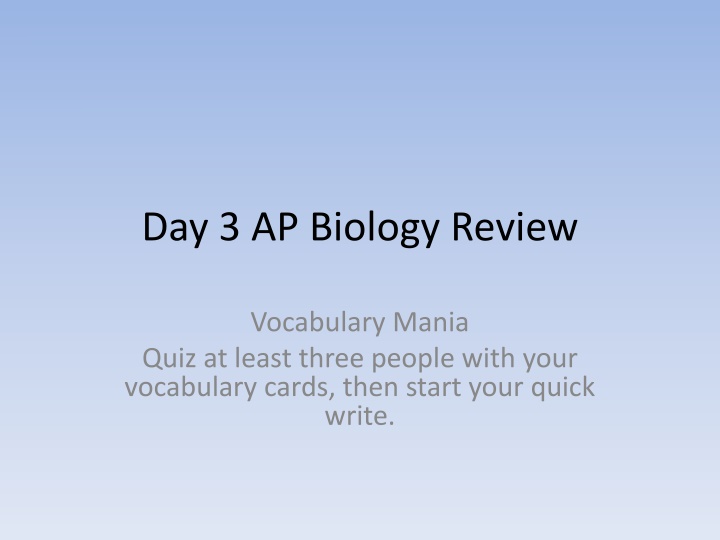
Exploring Bioenergetics in Living Organisms
This collection of resources delves into the intricate processes of bioenergetics in living organisms, focusing on energy transfer, photosynthesis, cellular respiration, food webs, regulatory mechanisms, and more. It includes vocabulary activities, quick write prompts, and lab investigations on plant pigments, photosynthesis, and cell respiration. The content explores how energy is harnessed, transformed, and regulated within cells and ecosystems. Additionally, it discusses the role of ATP, enzymes, feedback mechanisms, and the solar-powered nature of life through photosynthesis.
Download Presentation

Please find below an Image/Link to download the presentation.
The content on the website is provided AS IS for your information and personal use only. It may not be sold, licensed, or shared on other websites without obtaining consent from the author. If you encounter any issues during the download, it is possible that the publisher has removed the file from their server.
You are allowed to download the files provided on this website for personal or commercial use, subject to the condition that they are used lawfully. All files are the property of their respective owners.
The content on the website is provided AS IS for your information and personal use only. It may not be sold, licensed, or shared on other websites without obtaining consent from the author.
E N D
Presentation Transcript
Day 3 AP Biology Review Vocabulary Mania Quiz at least three people with your vocabulary cards, then start your quick write.
Quick Write Theme: Energy Transfer Photosynthesis Cellular Respiration Food Web Theme: Regulatory Mechanisms Feedback mechanisms Negative- cell signals for ATP, when has enough send signal to stop Positive blood clotting, Oxytocin, uterine contraction & milk let down Energy exercise, increase conversion of sugar for fuel Sleep energy is stored
Theme: Energy Life requires energy. In a short essay (100 150 words), describe the basic principles of bioenergetics in an animal cell. How is the flow and transformation of energy different in a photosynthesizing cell? Include the role of ATP and enzymes in your discussion.
Theme: Regulatory Mechanisms Regulation Everything from cells to organisms to ecosystems is in a state of dynamic balance that must be controlled by positive or negative feedback mechanisms. Example: Body temperature is regulated by the brain via feedback mechanisms.
Lab #4 Plant Pigments & Photosynthesis 1. What factors are involved in the separation of the pigments (name them) during the chromatography part of the lab? 2. What type of chlorophyll does the reaction center contain (chloroplast). What are the roles of the other pigments?
Lab #4 Plant Pigments & Photosynthesis Life is solar powered. Almost all the producers of the biosphere depend on energy from the sun to produce the organic molecules that supply the energy and carbon skeletons needed for life. In a short essay (100 150 words), describe how the process of photosynthesis in the chloroplasts of plants transforms the energy of sunlight into the chemical energy of sugar molecules.
Lab #5 Cell Respiration Testing the respiration rate of beans, create two sample hypotheses. Explain the effect of germination (versus non- germination) on pea seed respiration. If you used the same experimental design to compare the rates of respiration of a 25g reptile and 25g mammal at 10 C, what results would you expect? Explain your reasoning.
Lab #5 Cell Respiration During intense exercise, can a muscle cell use fat as a concentrated source of chemical energy? Explain In a short essay (100 150 words), explain how oxidative phosphorylation the production of ATP using energy derived from the redox reactions of a spatially organized electron transport chain followed by chemiosmosis is an example of how new properties energy at each level of the biological hierarchy.
Review for Ecology Quiz Trophic levels = Producers, Consumers, Decomposers Symbiotic Relationships Parasitism, Mutualism, Commensalism Organisms adaptations to environment Succession Biomes Habitat Niche Biomagnification Keystone species
